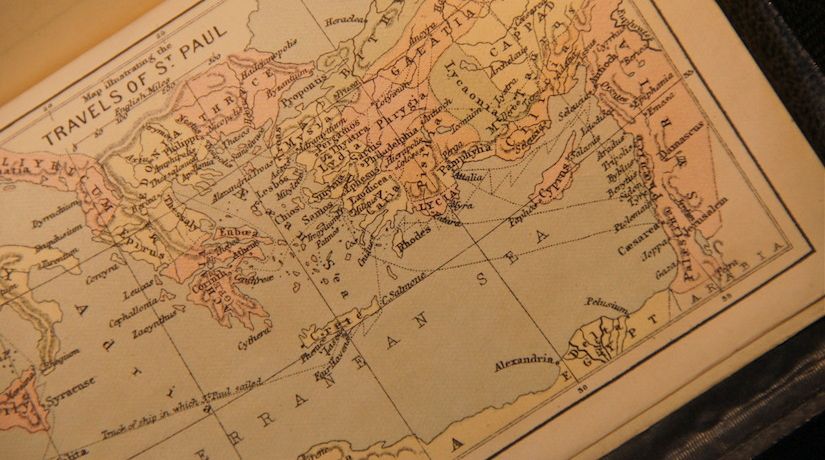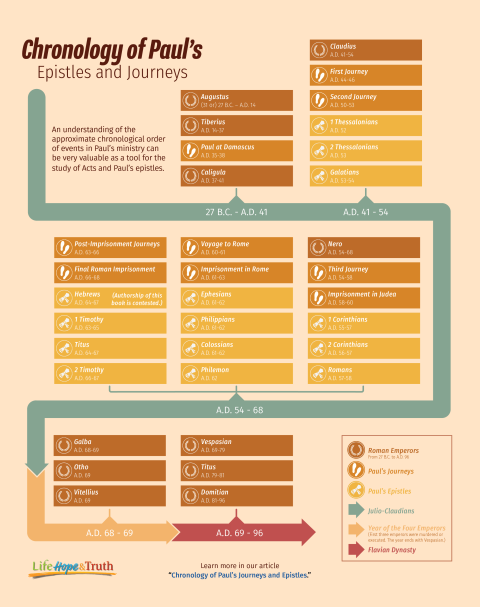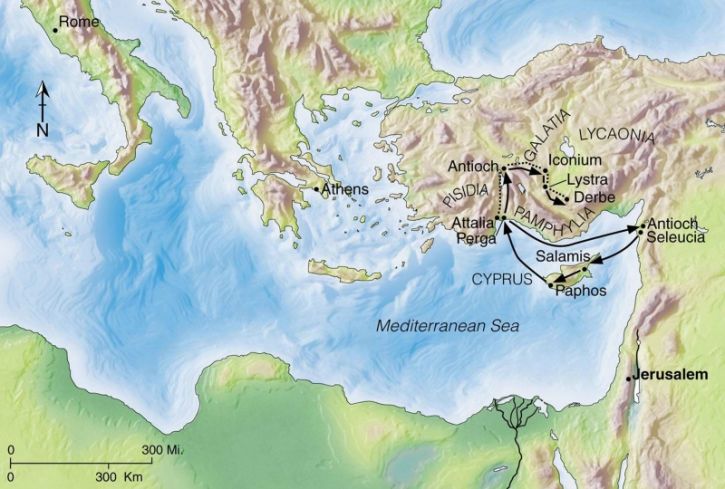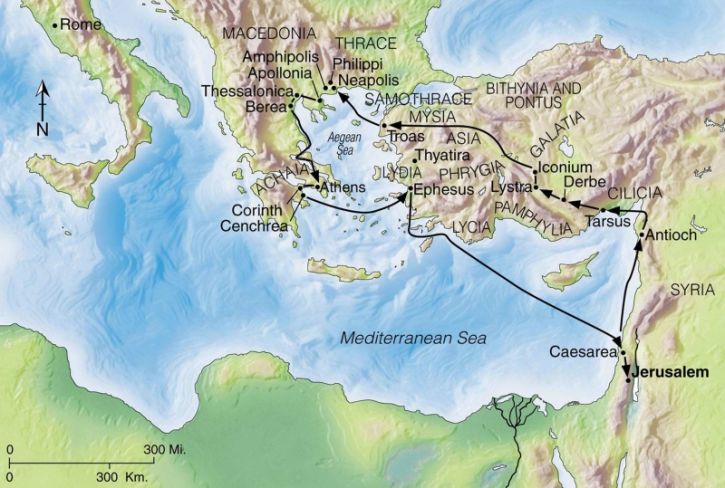An understanding of the approximate chronological order of events in Paul’s ministry can be very valuable as a tool for the study of Acts and Paul’s epistles.

The book of Acts and the Epistles of Paul sometimes tell us the length of time between one event and another. However, determining the year in which an event took place can require some research.
It is most helpful to know the year of the beginning or end of the reigns of political rulers that are mentioned in the text. Some of the more helpful dates in studying the events in Paul’s ministry are the death of King Aretas of Syria in A.D. 40, the beginning of the reign of Claudius Caesar as emperor of Rome in 41, the death of Herod Agrippa I in 44, the succession of Felix’s reign as procurator in Judea by Porcius Festus in 60.
Here is a summary of the approximate years of Paul’s journeys and his epistles. (Note: Other chronologies might also be reasonable and genuine Bible students could come to differing conclusions on some of these things.)
Chronology of Paul’s Epistles and Journeys Infographic
Chronology of Paul during the book of Acts
The crucifixion, resurrection and ascension of Jesus Christ occurred in the spring of A.D. 31 (all dates A.D.).
Shortly after, the formal beginning of the Church of God took place on the Day of Pentecost—June 17, 31 (Acts 2).
We are first introduced to Saul, who would later be called Paul, at the stoning of Stephen (Acts 7:58-59).
In about 35 Jesus Christ spoke to Saul (Paul) on the road to Damascus. Paul was led blind to Damascus (Acts 9:8). After the visit by Ananias, Paul then went to Arabia and returned to Damascus, the total time in Arabia and Damascus being three years (Galatians 1:17-18; Acts 9:22-23). In 37 King Aretas took control of Damascus when Emperor Tiberius Caesar died. Paul departed from Damascus at night, being let down from the city wall in a basket (Acts 9:25; 2 Corinthians 11:32). This could not have been after 40, the year that King Aretas died.
Paul met with Barnabas, Peter and James in Jerusalem (Acts 9:26; Galatians 1:18-19).
Paul was in Tarsus perhaps around 38-42 (Acts 9:30).
Peter visited the house of Cornelius (Acts 10).
Barnabas went to Tarsus to find Paul and brought him back to Syrian Antioch where they stayed for one year (Acts 11:26). This must have been between 41 (the beginning of Claudius Caesar’s reign) and 44 (Acts 11:28). Believers were first called Christians at Antioch (Acts 11:26).
James, the brother of John, was killed by Herod Agrippa I (Acts 12:2).
Herod Agrippa I died in 44 (Acts 12:23).
The first journey
Paul’s first journey began when Paul, Barnabas and Mark set out from Antioch (Acts 13:4). This journey started after 44 and ended a long time before 50, since Paul stayed in Antioch a “long time” after the trip (Acts 14:28).
Paul’s first journey
Then they sailed to Perga in Pamphylia, which is now southern Turkey. From here, John Mark returned to Jerusalem.
At Antioch in Pisidia (not to be confused with Antioch in Syria), Paul and Barnabas turned to the gentiles (Acts 13:46).
Then it was on to Iconium, where they abode a “long time” (Acts 14:3); Lystra, where Paul was stoned, but lived (Acts 14:19); and Derbe. Then they retraced their steps back through Lystra, Iconium and Antioch in Pisidia (Acts 14:21).
Paul and Barnabas went throughout Pisidia, Pamphylia, then to Perga and Attalia, and sailed back to Antioch in Syria (Acts 14:24-26).
The first journey ended in Antioch, Syria, where Paul and Barnabas stayed a long time (Acts 14:28).
The dates for the events from 50-60 are found by counting backwards from the succession of Felix’s reign as procurator in Judea by Porcius Festus in 60.
In about 49 Paul and Barnabas went to the council in Jerusalem 14 years after Paul’s conversion (Galatians 2:1-9; Acts 15:2).
Judas and Silas returned with Barnabas and Paul to Antioch (Syria), where they continued some days (Acts 15:35-36), possibly in the winter of 49-50.
The second journey
Paul’s second journey possibly began in the spring of 50. Paul took Silas through Syria and Cilicia (now southeastern Turkey).
Paul’s second journey
At Philippi God called Lydia and the Philippian jailer (Acts 16:14-34).
Passing through Amphipolis and Apollonia, they came to Thessalonica, where Paul taught in the synagogue for three Sabbaths, though the total time of his stay must have been longer.
After teaching some in Berea, Paul departed ahead of Silas and Timothy, southward into Achaia (now southern Greece), to Athens, where he stayed only briefly.
Paul then made his first visit to Corinth, where he stayed a year and a half (Acts 18:11). This may have been from the spring of 52 to the fall of 53. Here Paul met Aquila and Priscilla, who had just come from Rome, from which Claudius Caesar had banished all Jews in 49. Silas and Timothy rejoined Paul.
First Thessalonians was written from here in about 52 (1 Thessalonians 3:1-2, 6). We know that it was written from Corinth, and not from Athens, because Silas and Timothy had already rejoined Paul (1 Thessalonians 1:1; Acts 18:5). Second Thessalonians was also written from Corinth. We know that it was soon after the first letter because, as was the case with the first letter, Silas was with Paul when 2 Thessalonians was written.
After Paul left Corinth, there is no further mention of Silas traveling with Paul, though a Silvanus (Silas is the shortened form of Silvanus) is mentioned as serving with Peter in 1 Peter 5.
Paul went to the port of Cenchrea and sailed with Aquila and Priscilla across the Aegean Sea to Ephesus. Aquila and Priscilla stayed there where they would later meet Apollos (Acts 18:19, 26).
Paul sailed on to Caesarea and then went down to Antioch in Syria, where the second journey ends. Paul stayed a while (Acts 18:23). This may have been the winter of 53-54.
The third journey
Paul’s third journey began with Galatia (central region of Turkey) possibly in the spring of 54 and then Phrygia (Acts 18:23).
Paul’s third journey
Paul wrote 1 Corinthians near the end of this stay in Ephesus (1 Corinthians 16:8, 19), probably in 57 just prior to the Days of Unleavened Bread (1 Corinthians 5:8). It was not written with Timothy, whom Paul had sent ahead into Macedonia (Acts 19:22).
Paul foresaw his route of travel for the next four or so years in Acts 19:21-22. This agrees with his plans in 1 Corinthians 16:1, 3, 5, 8-10. Note how the “great door” opened to Paul and “many adversaries” in verse 9 compares with the events in the Ephesian amphitheater in Acts 19:23-41. In 1 Corinthians 3:6 Paul says, “Apollos watered.” This refers to Apollos teaching in Corinth when Paul was at Ephesus (Acts 19:1).
Paul had rejoined Timothy when 2 Corinthians was written (2 Corinthians 1:1). Paul had come to Troas and continued to Macedonia (2 Corinthians 2:12-13; 7:5), where he was joined by Titus (2 Corinthians 7:6, 13). This seems to correspond to Acts 20:1. Paul also wrote of a third visit to Corinth in 2 Corinthians 13:1 and 12:14. So 2 Corinthians was most likely written in the fall of 57 from somewhere in Macedonia (northern Greece), possibly at Philippi.
In 2 Corinthians 12:1-4 Paul said he knew a man (probably himself in a vision) who 14 years earlier had ascended into heaven. From 57, going back 14 years puts the event in 43, before Paul’s first journey, probably when he was at Antioch in Syria.
After going through Macedonia (northern Greece), Paul came to Achaia (southern Greece) where he stayed three months (Acts 20:2-3) and made his third visit to Corinth. This is where he spent the winter of 57-58 (1 Corinthians 16:5-8). Romans was written at this time (Romans 15:23-26; 1 Corinthians 16:1-3).
Going back to Macedonia (Acts 20:1), they were at Philippi (northeastern Greece) in the spring (April-May) of 58 during the “Days of Unleavened Bread” (Acts 20:6).
Then they sailed to Troas, where a young man fell out of a window while Paul was speaking and was raised from the dead (Acts 20:7-12).
Then Paul went to Assos, Mitylene, Chios, Samos, Trogyllium and Miletus (now in southwestern Turkey). From here, Paul addressed Ephesian elders whom he had called to meet him (Acts 20:17-38) in the spring of 58 (Acts 20:16).
Sailing to Cos, Rhodes and Patara and passing on the south side of Cyprus, they came to Tyre (which is now in Lebanon), where they stayed one week. Then they went south to Ptolemais and to Caesarea, where they stayed several days (Acts 21:10). Then Paul went to Jerusalem, where the third journey ended.
When was Galatians written?
At this point we haven’t discussed when Galatians was written. Galatians was written when Paul was not in prison and when neither Silas nor Timothy was with him (Galatians 1:1). It seems it was written after the council in Jerusalem (Acts 15:1-32; Galatians 2:1-10) and after Paul’s second visit to the region on his second journey in about 51 (Acts 16:1-6). Since they were “turning away so soon” from grace (Galatians 1:6), it must have been before the prison years of 58-63.
So it could have been written when Paul was alone in Athens in the winter of 51-52, which would make it Paul’s first letter. But this is unlikely, since Paul was only in Athens a short time (Acts 17:15).
Or it could have been written from Antioch between Paul’s second and third journeys in the winter of 53-54 (Acts 18:22-23). This is logical since he would be unable to get to them in the winter but he would be coming to them soon on his third journey.
It could also have been written in the winter of 57-58 from Corinth, where Paul wrote Romans.
Or it is possible that it was written from Ephesus during Paul’s three years there from 54-57, where he could have gotten the unfavorable report about the churches in Galatia (Galatians 1:6). However, it seems likely that if he was that close and the travel was relatively easy, he would simply have gone there instead of writing.
(Note: Some scholars date Galatians as early as the late 40s, shortly before the Jerusalem conference.)
The third journey ended at Jerusalem in 58. Paul was dragged from the temple and beaten by Jews, preached to them (Acts 22:1-21), and was brought before the Sanhedrin. Jesus Christ appeared to Paul, telling him that he would go to bear witness to Him in Rome. A group of 40 Jews vowed to kill Paul (Acts 23:12-13).
Paul’s imprisonment in Caesarea and Rome
In 58 Paul was taken to Governor Felix (who governed 53-60) at Caesarea, “many years” (Acts 24:10) after 53 and two years before the end of Felix’s reign. Paul then spent two years in prison in Caesarea in Judea.
Felix had started out as a slave and, through the influence of Nero, became the first former slave to govern a Roman province. He was ruthless and self-serving; Drusilla was his third wife. He was cruel, greedy, given to excess, treacherous—for instance, he had one high priest assassinated. Rebellion grew much stronger under his rule. He prided himself on maintaining order at any cost. Because of a dispute between Jews and Greeks in Caesarea, Felix used the military against the Jews. A delegation went to Rome to complain, and Felix was recalled and replaced in 60.
In 60 Governor Portius Festus replaced Felix. Though he could find no legitimate charges against Paul, Festus was reluctant to release him when he knew the Jews still wanted to kill him. When he proposed taking Paul to Jerusalem to be judged by the Sanhedrin, Paul exercised the Roman citizen’s right to appeal a capital case to Caesar (Acts 25:11).
Soon, Herod Agrippa II and his wife (who was also his sister) arrived to visit Festus and agreed to hear Paul.
Then Paul’s voyage to Rome began. Paul, still a prisoner (custodia militaris), sailed to Sidon with Luke and Aristarchus (Acts 27:1-3) on the way to Italy. They sailed to Myra (now southern Turkey) and on to Lasea, on the large island of Crete, about 50 miles southeast of mainland Greece, where they spent some time (Acts 27:7-13).
In the fall of 60, after enduring two weeks in a violent storm at sea, the ship was run aground at Malta (Melita in the King James Version), a small island south of Sicily. (Some believe the site of the shipwreck was Mljet off the coast of Croatia.) Paul was bitten by a poisonous snake but lived. Paul healed the father of Publius, the governor, and others. Paul (still captive) spent the winter of 60-61 (Acts 28:11) on the island with his captors.
In the spring, they sailed on to Syracuse (on the island of Sicily), then to Rhegium (on the southern tip of Italy), then to Puteoli (on the western coast of Italy, probably modern Terracina).
Then Paul was imprisoned in Rome. Paul spent two years in his own hired house (Acts 28:30) as a prisoner in Rome from 61-63. During this time he wrote Ephesians, Philippians, Colossians and Philemon, collectively known as the Prison Epistles.
What happened in Paul’s life after his imprisonment in Rome until his death? While these events took place after the book of Acts, there are still many clues.
In about 61-62 Paul wrote Ephesians before Timothy came to him in Rome (Ephesians 1:1; 3:1; 4:1; 6:20). Also in about 61-62 Paul wrote Philippians (Philippians 1:7) and Colossians (Colossians 4:18) with Timothy (Colossians 1:1) and fellow prisoner Aristarchus (Colossians 4:10). Paul apparently wrote Philemon near the end of his Roman imprisonment in 62 (Philemon 1:1, 22).
Chronology of Paul’s life after Acts
What happened in Paul’s life after his imprisonment in Rome until his death? While these events took place after the book of Acts, there are still many clues.
We know that Paul had further journeys after he was released from the prison in Rome in A.D. 63 (all dates A.D.). After his release, he wrote the epistles of Hebrews (though the Bible does not say who wrote Hebrews, many believe it was Paul), Titus, 1 Timothy and 2 Timothy, not necessarily in that order, although 2 Timothy was apparently his last.
This took place after the events recorded in Acts, so all of our information comes from various statements that Paul makes in his letters. In them are clues that Paul may have traveled to some or all of the following places: Colosse, Spain, Corinth, Miletus, Troas, Crete, Nicopolis, Philippi, Italy, Judea, Ephesus and Macedonia. This allows for the possibility that Paul traveled at this time to as many diverse places as in all of his previous journeys combined.
There are several possible ways that one could reconstruct the sequence of these travels that would not disagree with Scripture. The references below are not intended to be chronological, although they all occurred after Paul’s release from prison in 63.
In Philemon 1:22 Paul foresaw his release and tells those in Colosse to prepare him lodging. We know that Philemon was written to the Colossians because of Archippus (Colossians 4:17; Philemon 1:2), Onesimus (Colossians 4:9; Philemon 1:9-10) and others (Colossians 4:10-14; Philemon 1:23-25). Also, while in prison in Rome, Paul wrote to those in Philippi that he might be coming to visit them (Philippians 1:26).
In Romans 1:10 and 15:24-28 Paul speaks of aspirations of eventually going to Spain, and this would undoubtedly include areas of southern Gaul. Did he ever do this in his final years?
The Bible does not say whether he did or not. We do, however, have the account of the second-century author Clement of Rome (around 100) regarding Paul: “After preaching both in the east and west, he gained the illustrious reputation due to his faith, having taught righteousness to the whole world, and come to the extreme limit of the west, and suffered martyrdom under the prefects” (The First Epistle of Clement to the Corinthians, chapter 5).
The “extreme limit of the west” could very well be Spain, or even Britain.
At some time after being released from the prison in Rome, Paul went to Corinth and Miletus (2 Timothy 4:20). He also went to Troas (2 Timothy 4:13), Crete (Titus 1:5) and Nicopolis for the winter (Titus 3:12).
Paul’s leaving Titus in Crete must have been during a period of liberty after Paul’s first imprisonment in Rome ended. Paul did not go to Crete during the first three journeys. There is no mention of Titus or of any preaching on Crete on the voyage to Rome in Acts 27:7-13. Paul says he will send Artemas or Tychicus to Titus. He tells Titus to come to Nicopolis, where Paul has determined to winter (Titus 3:12). The letter to Titus was probably written around 64-65. There are three cities called Nicopolis: (1) in Achaia (southern Greece), most likely the one to which Paul was referring, (2) 15 miles west of Jerusalem and (3) in the area that is now Romania.
The book of Hebrews was apparently written from Italy (Hebrews 13:24) by Paul (though the book does not name its author and many scholars today don’t believe Paul wrote it). Timothy had been released from prison (Hebrews 13:23) and was coming to Paul. Paul may have been at liberty as well, since they hoped to then go to visit the Hebrews. This could have been in Judea, as Paul says, “For you had compassion on me in my chains” (Hebrews 10:34). This was probably in reference to Paul’s imprisonment in Caesarea from 58-60. Hebrews was probably written around 64-67.
Paul had told Timothy to stay and teach in Ephesus when Paul went to Macedonia (1 Timothy 1:3). During the third journey, Paul had done the opposite, staying in Ephesus himself and sending Timothy with Erastus to Macedonia (Acts 19:22). So 1 Timothy was written around 64-65 during a period of liberty after Paul’s Roman imprisonment of 61-63.
Paul said he was hoping to come to Timothy in Ephesus shortly, but might have to tarry long (1 Timothy 3:14-15). Timothy was in Ephesus where he received both 1 and 2 Timothy (1 Timothy 1:3; 2 Timothy 1:16-18; 4:14, 19; Acts 19:33).
Apparently, 2 Timothy was written from prison (2 Timothy 1:8) with Paul ready to die (2 Timothy 4:6-8), possibly about 67. Yet he asks Timothy to come to him before winter (2 Timothy 4:9, 21). Paul was probably martyred not long before Nero’s suicide on June 9, 68.
Read more about Paul and his letters in the section “Epistles of Paul.”




